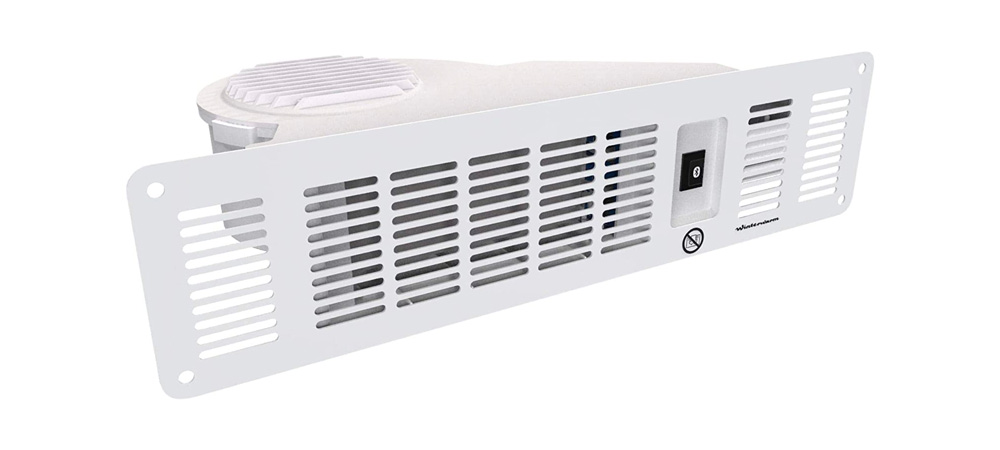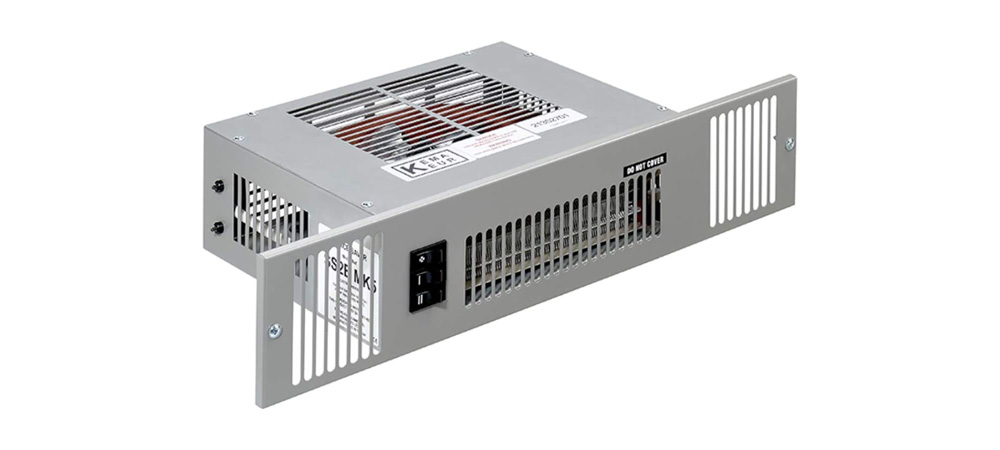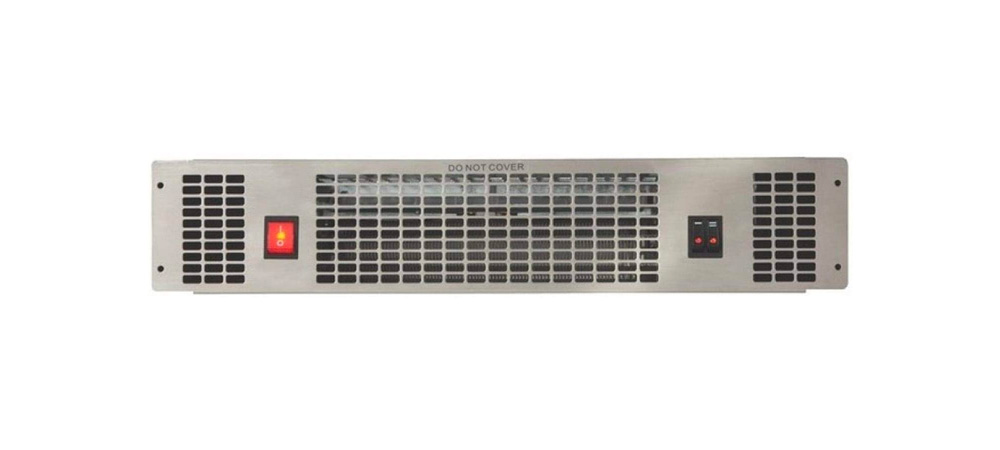Best Electric Plinth Heaters (Reviews) in 2023: BUYING GUIDE
Whether you’re looking to renovate your kitchen units, upgrade your existing central heating system, or just need a sleek heating solution for your new house extension, a plinth heater can tick quite a few boxes off your search. But how do they work, are they better than the alternatives, and which one offers the best value for money?
Today, we answer these questions and more in our review of the top electric plinth heater models.

What is an electric plinth heater?
If you’re asking this question, chances are good you’re not 100% certain what a plinth is. That’s okay, as most people actually get the definition wrong.
A plinth is a sort of hollow base that exists beneath your cabinetry. They were first put into use in order to form a barrier keeping rodents and bugs from ransacking your cupboard. But in modern times, a plinth also doubles as a convenient hidden space within which you can run electric cables throughout the kitchen.
An electric plinth heater takes full advantage of this second use-case, installing directly into the side of your plinth, then drawing power from your mains without any messy cables showing. An electric plinth heater is individually controlled. A hydronic plinth heater connects to your central heating system. It’s a compact warming solution that confers several advantages unavailable in other categories of heaters.
So, why shouldn’t I just use a plug-in space heater or panel radiator?
An electric plinth heater helps you conserve space and takes advantage of the fact that heat naturally rises.
Indeed, plug-in electric space heaters abound on the market in all shapes, sizes and price points. But they all share a common inconvenience: they take up space that could otherwise be put to other (better) uses.
Even the most compact column heaters have an unavoidable footprint and pose a tripping hazard with their electric cables. Meanwhile, panel heaters can monopolise entire walls, severely limiting your options for décor and cabinetry.
An electric plinth heater, on the other hand, has none of these problems. It hides away mostly out of sight, occupying space that would otherwise go to waste beneath your cupboards. There’s no tripping hazard, and you don’t have to sacrifice precious kitchen space in order to stave off the wintry weather. Some plinth heaters connect directly with your central heating system. A hydronic plinth heater offers you, even more, savings and value for money.
But that’s really only half of it! The other main advantage of plinth heaters is based on physics. You may remember from your science lessons in primary school that warm air tends to rise; installing plinth heaters is thus the ideal vantage point for really circulating warm air throughout the room.
What’s more, tile, stone, and wood floors all tend to get uncomfortably cold much quicker than the rest of the room. By producing warmth at foot-level, plinth heaters get immediately to work heating up the area that needs it most.
What are the best electric plinth heater models for my kitchen?
So now you’ve got a good understanding of what makes plinth heaters tick, and you’re ready to take the dive. Here, we present the results of our own comparison shopping to help you suss out which is the best electric plinth heater for you:
1. Winterwarm WWFH20E Electric Plinth Heater
Glen Dimplex are a household brand with high-quality heating solutions for virtually any application, so it should come as no surprise their plinth heaters are some of the best in class. The WWFH20E is their best-selling electric plinth heater, and it’s easy to see why with its stylish good looks, powerful heating element, and quality of life provisions.
(Side note: if you’re looking for a plinth heater with remote control, look no further — this is the model for you).

The Winterwarm WWFH20E electric plinth heater features a generous 2,000W heating element, with enough heat output high enough to turn frigid feet into toasty toes in kitchens as large as 2,000ft3. Of course, if you don’t need all that power, you can simply dial it back heat settings on the thermostat.
But don’t think you’ll be getting on your hands and knees to fiddle with a small dial on this appliance. The WWFH20E electric plinth heater, with its remote control, is definitely made for 21st century homes. Not only can you change the heat settings, but you can also programme it to operate on a 7-day timing schedule via the Bluetooth remote.
While the Winterwarm electric plinth heater is all about “set it and forget it”, you always have manual control over the heat settings, turning it on and off with a simple switch set upon the device itself. Better yet, the switch illuminates with a red neon to indicate the heating element is indeed on and producing heat.
Worried about safety? Don’t be, as there are both thermal and electrical overload cut-out switches. Moreover, you never have to worry about burning your toes on the grille – the WWFH20E electric plinth heater uses clever design and modern materials to ensure the surface never gets too scalding.
Finally, whilst looks are mostly up to subjective taste, we rather like the simple horizontal vent patterning adorning the clean-white grille. The switches are large enough to handle, but slight enough so as not to present an eyesore in your kitchen space.
WWFH20E electric plinth heater at a glance:
- 2,000W Electric heating element good for up to 250 sq. ft.
- Bluetooth remote-controlled programmable thermostat and 7-day timer
- 1-year manufacturer guarantee
- 41 x 11 x 21.5 cm
2. Smith’s Space Saver SS2 EW Electric Plinth Heater
Most kitchen plinth heaters lie nestled under your kitchen units, politely out of sight, and out of mind by design. At first glance, the austere stainless steel grille of the Space Saver SS2EW fits this mould perfectly. However, UK-based manufacturer Smith’s allows you to accent your décor, providing 6 different coloured overlay grilles to choose from (brown, chrome, brushed steel, gold, black, aluminium).

But of course, in heating form must always follow function, and the SS2EW electric plinth heater delivers performance in spade. By default, its heating element runs at 2000W for an output of 6280 BTU/hr. However, you can also cut the power in half (1,000W @ 3410 BTU/hr) to save energy or better fit smaller spaces.
Need more control? Smith’s ships their SS2EW electric plinth heater with a programmable thermostat unit, which installs semi-permanently nearby the plinth heater for convenient access. Set it between 15 and 35° during the Winter, or kill the heat altogether and use the fan to circulate cool air during Summer.
Unless you really know what you’re doing, you’ll probably want to hire an electrician to get this (or any) electric plinth heater installed properly. But that’s the only prerequisite, as the Space Saver neatly slots into any standard electric mains.
The only possible knock against this unit is the lack of a neon power indicator. Then again, the heating control module will doubtless sit in a visible area, readily displaying the current operational setting.
SS2EW electric plinth heater at a glance:
- Three modes of operation: 1kW, 2kW, or fan-only for cool air
- Semi-permanent thermostatic control unit included
- Amazing 5-year warranty
- 6 grille colours available
- Quiet fan at just 42 dBA
- 50 x 10 x 14 cm
3. CDA APH01SS VP-KGUV-UZZ4 Electric Plinth Heater
Last but not least is another best-selling electric plinth heater in the form of CDA’s APH01SS. Many people opt for this one because of how simple it is to install. While it can indeed be wired directly into the mains via fused spur, it is also easy to swap out the leads for a standard 3-pin plug (not included).

That means all you’ve got to do is cut the hole in your plinth, run the cable through to a receiver and plug it in. Then screw the fascia into place, and you’re done! There’s virtually no reason to ever opt for a plug-in space heater, which will hog your floor space in exchange for ease of use.
On its own merits, the APH01SS is an exceptional electric plinth heater through and through. It boasts superior utility, with 3 operational settings: 1kW standard, a 2kW boosted setting for warming your frigid tile or wooden floors quick, and finally, a warm-weather mode that blows a refreshingly cool breeze.
Note that whilst the APH01SS is a highly effective electric plinth heater, it lacks any form of thermostatic control. Instead, there’s a single illuminated power switch that controls the fan, plus two power toggles for activating the heating element. It’s not as convenient to control as other plinth heaters, but then again, you may find you appreciate the elegant simplicity.
In terms of aesthetics, the APH01SS is a bit of a Plain Jane. And whilst its grille design is entirely inoffensive, it will mostly be hiding out of sight anyway.
True to form for an appliance that demands little interaction from its owner, the APH01SS features excellent automated safety measures. It cuts the power if it detects a surge in power or temperatures approaching unsafe levels.
APH01SS electric plinth heater at a glance:
- 5-year guarantee on parts, 2 years on labour (just make sure to register with 28 days of purchase!)
- Automatic safety switch
- Simple three-switch operation for normal and high heat, plus cool-blown air
- 50 x 10 x 22.5 cm
Electric Plinth Heater: FAQ
What’s the difference between electric and hydronic plinth heaters?
Plinth heaters draw power from your mains to operate an internal heating element, then blow the heat with a fan through the grille into your kitchen. In contrast, whilst the hydronic version still uses electricity to power the plinth fan, the heater lacks a powered heating element. Instead, a hydronic plinth heater taps into your central heating system, which pipes hot water through an array of coils inside the heater.
Overall, hydronic plinth heaters are more energy-efficient than their electric counterparts but less flexible in where you can deploy them. If you’ve got a room your central heating system can’t reach, hydronic plinth heaters are of zero value to you as a heating solution.
Electric plinth heaters have no such restrictions. So long as there’s access to the electric mains in relatively close proximity, you can complete installation with relative ease.
And here’s another difference; take note of it if dry air irritates you. An electric plinth heater produces drier, more immediate heat, whilst its hydronic peers give off gentler, slower warmth.
Is it easier to install a hydronic or electric plinth heater?
If we’re talking about kitchen heaters, electric models are always easier to plug in under the cabinetry. Just imagine ripping out cabinets to hook up an appliance to your central heating system; doesn’t sound like a fun, simple task, does it?
Be advised, however, that most plinth heaters don’t ship with 3-pin plugs, and instead require installation via a fused spur. While this is easy enough for DIY installation, it’s a lot safer to hire a technician. (Though, it is relatively simple to swap out the lead with a pronged cable on your own.)
Hydronic plinth heaters, on the other hand, pretty much require the services of a licensed professional to complete installation safely.
Is it difficult to fit an electric plinth heater by yourself?
With the right tools and a modicum of DIY experience, not at all! But there are a few pitfalls to be aware of.
First, there are really 2 sets of product dimensions: 1 for the grille area, and 1 for the overall volume of the heater. Remember that the plinth heater will slot into a hole you cut into the plinth, while the grille will overlay a margin around that hole.
You’ll want to make sure that your plinth is overall tall enough to accommodate the height of the grille, plus a small margin to allow clearance above the floor and below the cabinet doors.
The clearance of the unit inside the plinth is much more important. Depending on the model, you’ll need anywhere from 2-5cm between the plinth heater and the drawers above/the floor below to allow for sufficient airflow.
From there, it’s a matter of hooking the electric cable up to the mains via a fused spur. You can look up tutorials on how to do this safely, but we’re quicker to recommend you hire an electrician if you’re not extremely confident working with electrical wiring.
The consequences of a botched job include electrocution and fire–neither of which are worth the money saved on a haphazard DIY attempt. What’s more, many manufacturers only honour warranties based on proper installations, so having a receipt from your electrician will be key to getting service down the line.
But if you’re at all competent with electricity and have the tools for cutting into the plinth, it’s really quite an easy matter to install an electric plinth heater. Otherwise, the safest and most cost-effective course of action would be to cut the hole yourself, then hire someone for the rest.
How much does an electric plinth heater cost to run?
This is a tricky question to answer definitively, as power costs vary across the country, some units are more efficient than others, and your home may or may not have top-notch insulation.
But doing some general maths, we’ll start with the average cost of electricity in the UK, which is 14.37p per kWh. Assuming you run your 2kW plinth heater at full tilt for 5 hours a day, you’re looking at around £0.72 per day, or just over £5 per week.
Of course, plinth heaters with thermostatic control are designed to cut off when nominal temperatures have been reached. And, this allows for significant savings under that £5/week number. Additionally, many models allow you to reduce the power, usually to 1kW, which effectively halves the power usage.
So, on paper, plinth heaters run at a similar efficiency to plug-in space heaters. However, you also need to factor in the floor-level heating of the plinth heater, which more evenly distributes the heat relative to a taller radiator. You will likely require less “on” time with a plinth heater to achieve a similar feeling of warmth, and thus lower costs.
How much power do I need to heat my kitchen/workshop/space adequately?
Whilst most product listings for plinth heaters mention the device’s wattage, the real-life heat output is measured in BTUs. So, you want to match the size of the room you’re heating to the BTU capability of your chosen heater.
There are many dedicated BTU/m3 calculators out there, but we’ll give you some back-of-envelope calculations to help your comparison shopping. Say your kitchen is 1,000ft3; you can multiply that by 3 to yield a 3,000BTU requirement. Your average 1,000W heater is capable of producing somewhere around 3,400BTUs, so with some thermostatic control, you should be able to hit the sweet spot.
Again, this is only a rough estimate. But, it allows you to categorically strike off those devices with a heat output that is clearly beyond what oy need. Too much power may trigger the overheat protection switch, while an underpowered heater will waste energy and give you subpar results.
Parting Words
Sick of dealing with that massive radiator or space heater taking up your precious floor or wall space? Then consider an electric plinth heater. Not only do they offer superior heating to many of their larger cousins, but you can also install them independently of your heating system.
We’ve gone through the ins and outs of what makes an electric plinth heater such an attractive option. We’ve shown you our picks for the best plinth heater for your home. The rest is up to you. Feel free to let us know in the comments if this article helped, and which model plinth heater you opted for.